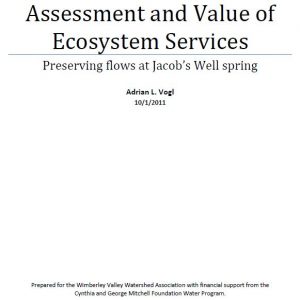Assessment and Value of Ecosystem Services: Preserving flows at Jacob’s Well spring

This report was prepared for the Wimberley Valley Watershed Association with financial support from the Cynthia and George Mitchell Foundation Water Program.
Jacob’s Well is the largest perennial spring in the Trinity Aquifer and one the longest underwater caves in Texas. The cave and spring are inhabited by uniquely adapted spring and aquifer fauna. The artesian spring provides a base flow of thousands of gallons of crystal clear water per minute to form Cypress Creek and the beautiful Blue Hole swimming area. The spring also helps support a thriving ecological community in the Cypress Creek by historically providing a consistent source of fresh, clear water to the surface, even during prolonged droughts. This natural treasure is now threatened by pollution and increased groundwater pumping caused by rapid and water-intensive development in the area. Because flow at Jacob’s Well is very sensitive to groundwater levels in the Middle Trinity Aquifer, the spring is the proverbial canary in the coal mine for the health of the underlying aquifer. The spring flowed through the 1950’s drought of record; yet in last decade Jacob’s Well has stopped flowing several times in response to much less severe droughts than were experienced in the 1950s.
Growth in the recharge and contributing areas to Jacob’s Well may have significant impacts on spring flows there, but policy and planning in the area lacks a coherent framework for evaluating the impacts of such development, prioritizing areas for conservation efforts, and comparing the values derived from maintaining ecosystem services in place (such as recharge and water quality mitigation) versus the economic returns of conventional land development. The concept of ecosystem services is useful for integrating economic and ecosystem considerations into a common framework for assessing the costs and benefits of land conservation strategies. Water-related ecosystem services in the Texas Hill Country are diverse, and include water capture (infiltration), water storage (recharge), in-stream flows, channel-based aquifer recharge, and water quality protection.
An ongoing issue with incorporating the concept of ecosystem services into conservation planning is the need to define exactly what is being valued. In order to adequately assign economic values to specific ecological services, it is first necessary to quantify those services and to understand the spatial distribution of the land characteristics and uses that provide them. WVWA recently completed a comprehensive assessment of the water-related ecosystem services that support Jacob’s Well spring flow and the economic value of associated lands to assist long-term planning and land conservation. This study summarizes what is known about the hydrogeology and vulnerability of Jacob Well’s watersheds, but also reveals that there are still many gaps in our scientific knowledge of the aquifer system itself. The assessment of ecosystem services in the Jacob’s Well area involves:
-
- Delineating a probable contributing area for Jacob’s Well spring based on existing hydrogeologic studies
- Mapping ecosystem service provision in the probable contributing area using a combination of data collection, watershed modeling, and GIS analyses
- Developing a composite index map that demonstrates the areas with highest overall ecosystem services provision to assist in prioritizing conservation efforts
- Performing economic value assessment of water-related ecosystem services in the study area